Turning Japanese
 fig. a: Laser Suzuki!
fig. a: Laser Suzuki!
It may have had something to do with the Laser Suzuki t-shirt that a friend of mine got me for my birthday last year, somewhat inexplicably. I've definitely been wearing it a fair bit recently, much to the puzzlement of those who know me well and who can't understand the message.* Or maybe it was all those travel tales from Japan that we've been hearing over the last several months from all those friends who've insisted, "You really must go! It's not as expensive as you think!" Then again, it may also have been the effects of that full-on Kazu fever that we developed this spring and that has yet to relent in spite of weekly (bi-weekly?) visits. All I know is that, for a while there, our AEB test kitchen was all about the Japanese. fig. b: Harumi!
fig. b: Harumi!
And when we felt like we need a little help with this process, our newest favorite friend, Harumi, was there to guide the way. I was none the wiser until quite recently, but Harumi Kurihara is something of a sensation in Japan. A former housewife turned "lifestyle authority," Harumi has apparently gone platinum many times over with her assortment of cookbooks, interior design books, lifestyle magazines, etc. But all of that is just hearsay.
All we really know is that Everyday Harumi: Simple Japanese Food for Family & Friends, her follow-up to her award-winning Harumi's Japanese Cooking (her first book in English), is a smash hit in our household. Everyday Harumi features some 70 homestyle Japanese recipes and a whole lot of gorgeous photography, and, as the title suggests, this is a book that focuses on recipes that are unfussy and that one might make on an everyday basis, many of which call for a minimum of ingredients. Best of all, they've all been winners so far, fig. c: three toppings!
fig. c: three toppings!
from the Three Toppings Rice, which is a kind of "mother & child"/"chicken & egg" number,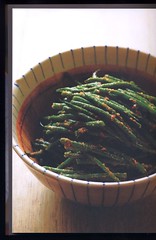 fig. d: green beans!
fig. d: green beans!
to her deliciously simple, simply delicious Green Beans with a Sesame Dressing (the same ones she's stirring in the photograph that graces the cover),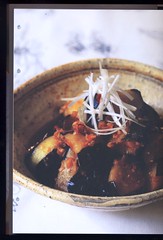 fig. e: eggplant!
fig. e: eggplant!
to her Eggplant in Spicy Sauce--another ultra-straightforward, ultra-satisfying gem.
Michelle's been in heaven throughout this entire recent foray into all things Japanese, but for some reason she found the Eggplant in Spicy Sauce to be particularly brilliant, so that's the recipe I've decided to highlight.
Eggplant in Spicy Sauce
1 lb 3 oz eggplant (either Japanese, or baby Italian)
1/3 cup light soy sauce, such as usukuchi
1/3 cup mirin
2 1/2 tbsp superfine sugar (not to be confused with icing/confectioners' sugar)
1/4 cup rice vinegar
sunflower, canola, or vegetable oil for deep-frying
2-3 tbsp finely minced leeks or scallions
1 tsp finely minced garlic
1 tsp finely minced ginger
1-2 red chilies, seeded and finely sliced
shredded leek for garnish
Trim the eggplants and, using a vegetable peeler, make some stripes in its skin. Cut the eggplant into 1-inch thick disks and then quarter them. Place the chopped eggplant in a bowl of cold water, soak for 10-15 minutes, then drain and pat dry.
Combine the soy sauce, mirin, sugar, and rice vinegar to make the sauce. Stir well and set aside.
In a skillet, heat enough oil to cover the eggplant. When the oil reaches 340º F, add the eggplant pieces, and deep-fry until the pieces are golden all over and buttery soft in the middle. Remove the eggplant pieces from the skillet with a slotted spoon and drain on paper towels. Repeat process as necessary. You should be able to deep-fry all the eggplant in no more than 2-3 batches. The eggplant pieces cook quite rapidly--3-4 minutes, usually--so even 3 batches of deep-frying won't take long.
Transfer the eggplant pieces to a bowl, add the sauce, then the minced leek or scallion, garlic, ginger, and chili to combine.
Serve with some shredded leek on top, or some finely chopped scallions.
[recipe from Everyday Harumi by Harumi Kurihara]
One night we had a really lovely simple meal that consisted of the Eggplant in Spicy Sauce, the Green Beans with a Sesame Dressing, steamed short-grain rice, and an assortment of simple Asian pickles,
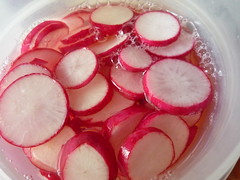 fig. f: pickled radishes!
fig. f: pickled radishes!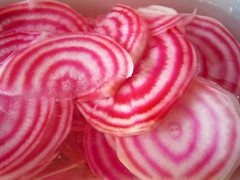 fig. g: pickled beets!
fig. g: pickled beets!including pickled cucumbers, pickled radishes, and pickled beets.
On special occasions, we've been combining recipes from Everyday Harumi with some of the more Japanese or Japanese-inspired recipes from David Chang's Momofuku cookbook.
 fig. h: Asian cherry tomato salad!
fig. h: Asian cherry tomato salad!One day we even made his wonderful Cherry Tomato Salad with Silken Tofu & Shiso,
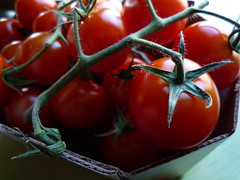 fig. i: cherry tomatoes!
fig. i: cherry tomatoes!which required us to score the best cherry tomatoes we could find,
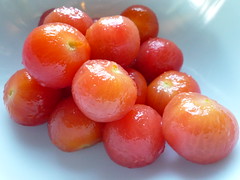 fig. j: naked cherry tomatoes!
fig. j: naked cherry tomatoes!before blanching and peeling some of them (others were left uncooked and fully clothed).
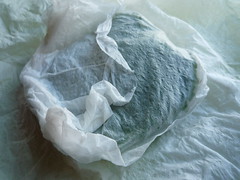
 fig. k: shiso leaves!
fig. k: shiso leaves!It also required us to hit up our friendly, neighborhood sushi restaurant (one of the city's very best) for some real, honest-to-goodness Japanese shiso leaves, which was kind of like hitting up your neighbor for a cup of sugar or a stick of butter or something, only way more magical.
aj
* I mean I'm down with David Suzuki, the David Suzuki Foundation, and The Nature of Things, but suddenly I'm reminded of a story I once heard about the chair of an anthropology department at a prestigious Canadian university. The chair in question was a diminutive Japanese man who'd cultivated a convincing Ho Chi Minh mustache and beard combo. His office was adorned with a single, solitary bit of decoration--a massive poster of Karl Marx. The Ho Chi Minh look + the Karl Marx poster seemed to suggest that this gentleman was a card-carrying Marxist--most who visited him in his office drew what appeared to be the logical conclusion. In fact, appearances were deceiving. He just liked the way the poster looked.**
** Presumably, he also just liked the way that Ho Chi Minh mustache and beard combo looked.









6 comments:
I have been looking for a recipe like this for ages...so thank you!! I have Harumi on my wish list for chapters
I'm going to be a bit of a spoilsport here. Do you know how much sodium is in soya sauce? One tablespoon of "lite" tamari contains 700 mg of sodium. One-third of a cup of that would be right off the map!
Canadians consume on average 3,100 mg of sodium a day, which is twice the recommended amount.
OMG! The tomato salad looks drool-worthy!
I love this post. I hope this Japanese lust/thrust will inspire her to experiment with daifuku. I freakin' LOVE daifuku, and if she needs inspiration here's a link:
http://www.flickr.com/search/?w=all&q=ichigo+daifuku&m=text
Since it's still strawberry season.
xo
cb
Did you just walk into Jun-I (or wherever) and ask to buy some shiso leaves off them, or do you have a special hook-up, or what?!
Hi, NS,
I think you're going to love Harumi--she's a sweetheart
Hi, AM,
wow, that is a bit of a buzzkill--you can make adjustments as needed--the main thing we wanted people to come away with was the technique, which is a simple and excellent way to turn fresh eggplant (which are in all their glory right now!) into little jewels of goodness--the method is very similar to one that Marcella Hazan recommends for making her pasta sauce with eggplant--dress the eggplant as you like--we'll continue using Harumi's specifications--we're not too worried about our sodium intake
hi, P,
it's really, really good--do you need the recipe?--I can put it up, if you like
hi, K,
neither Michelle nor myself had ever heard of daifuku--color us seriously intrigued--thanks for the 411!
hi, MK,
yeah, just walked in and asked very, very politely (Japanese -style)--we had to pay a nominal fee, but it was really worth it--totally made the salad
thank you all for writing...
Post a Comment